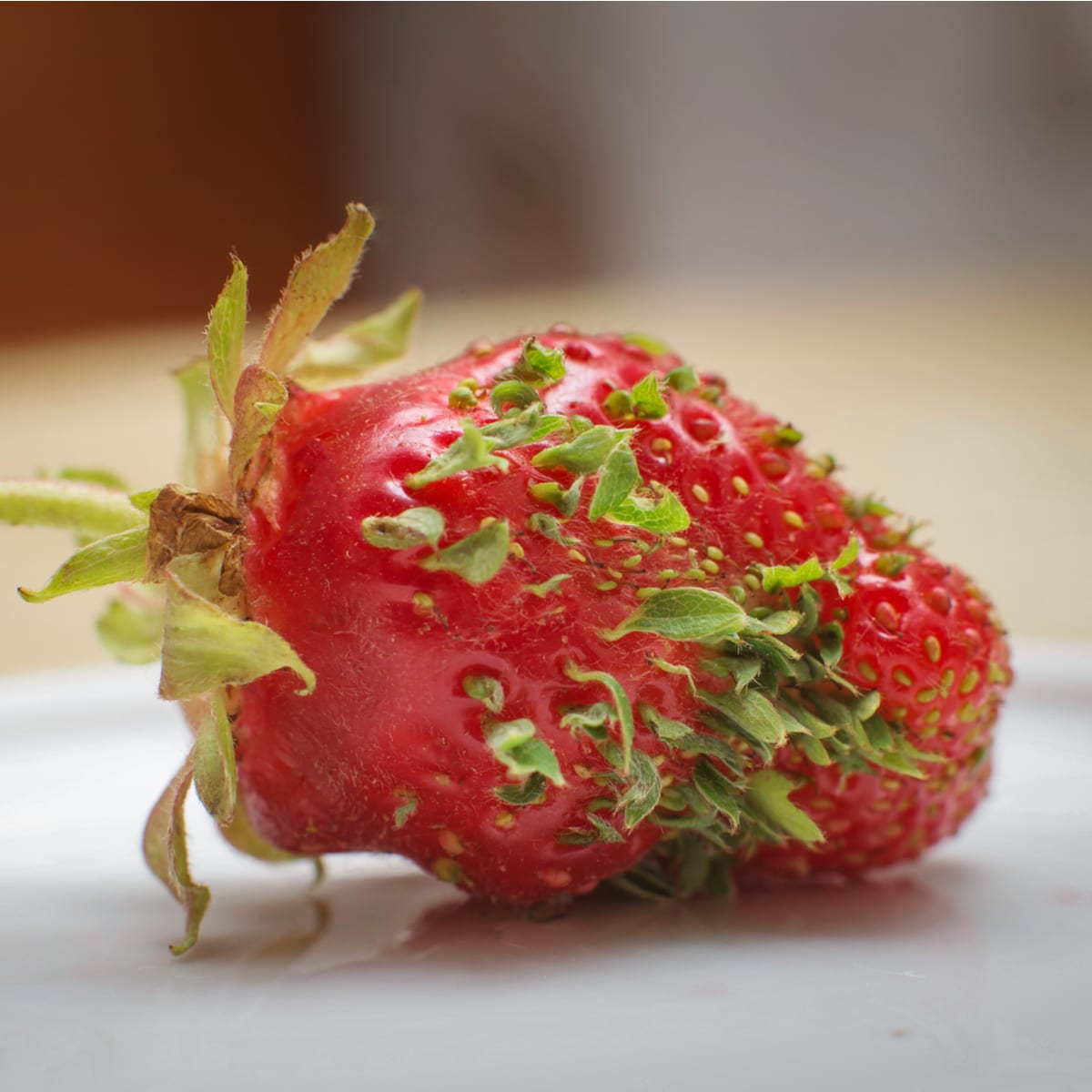To germinate strawberry seeds quickly and effectively, simply place the seeds on the soil surface and lightly cover them. Strawberry seeds need plenty of light to germinate, so do not bury them too deeply.
Mist the soil daily to keep it moist, but be careful not to overwater as this will disturb the seeds’ growth. Providing a strong light source above the seeded flat will help with germination. In addition to cold stratification, strawberry seeds require light to germinate and will typically sprout in one to six weeks.
If your seeds are not germinating, it may be due to too much or too little water. Ensure you follow the correct care guidelines for your strawberry seeds to ensure successful germination. We will discuss how to grow strawberries from seed and provide tips and tricks to help your seeds sprout into healthy and productive plants.

Credit: strawberryplants.org
Collecting And Preparing Seeds
To germinate strawberry seeds, start by collecting ripe fruit and dry the seeds from it. Barely cover the seeds with soil and provide a strong light source, mist the soil daily to keep it moist but not wet. Avoid watering too intensely, which may disturb the seeds and prevent germination.
Keep the plants warm and watered and strawberry plants will soon sprout from the seeds.
Collecting and Preparing Seeds: Collecting Strawberry Seeds To collect strawberry seeds, you need overripe strawberries, a spoon, and a fine-mesh strainer. Crush the strawberries and remove the seeds using a spoon. Rinse the seeds under cold water to remove any pulp. Strain the seeds using a fine-mesh strainer.Drying Seeds After removing the pulp, dry the seeds thoroughly. The best way to dry the seeds is to spread them on a paper towel and let them air dry for 3-4 days. You can also dry them in a dehydrator or under low heat in an oven.Storing Seeds in Refrigerator Once the seeds are dry, store them in an airtight container in the refrigerator. The ideal temperature for strawberry seeds storage is between 32-41°F. They can be viable up to 2 years in the fridge.Remember to label the container with the date you collected the seeds and the variety of strawberries. It’s important to give your seeds an adequate chilling period of 2-3 weeks before sowing them.
Credit: m.youtube.com
Seed Starting Mix And Soil Preparation
To germinate strawberry seeds, it is important to use a seed starting mix with good drainage and proper soil preparation. Barely cover the seeds with soil and mist them daily, ensuring they receive plenty of light to help them germinate.
Avoid overwatering the seeds as they may become disturbed or infected with soil-borne fungi.
Seed Starting Mix and Soil Preparation
|
| To germinate strawberry seeds quickly, cover the seeds with soil and mist daily to keep the soil moist. Be careful not to overwater, as this can cause the seeds to rot. It is recommended to provide a strong light source above the seeded flat to promote germination. Before starting, choose an appropriate seed starting mix that drains well and provides necessary nutrients. Regarding soil preparation, ensure that the soil is moist but not too wet. Strawberry seeds require light to germinate, so press the seeds into the surface but do not cover them. Stratification, labeling, and transplanting are also important factors to consider when germinating strawberry seeds. |
Starting Seeds Indoors
Learn how to germinate strawberry seeds from the comfort of your own home with a few simple steps. Plant the seeds in a mix of soil and provide ample light, water, and warmth, and watch as your strawberry plants grow.
ne to three weeks if they are kept moist and the temperature is kept between 65 and 75°F. To sprout strawberry seeds, you can use a seed starting mix and stratify them for germination. It is important to determine the ideal time to start seeds indoors, and fertilize them after germination. However, it is not necessary to use humidity domes. To start strawberry seeds indoors, make sure to label them for proper identification. When the seedlings are ready, transplant them to a warm location and keep them watered. With proper care and attention, you can grow your own strawberries from seed and enjoy the sweet taste of fresh strawberries grown in your own garden.
Credit: m.youtube.com
Fertilizing And Care For Seedlings
To germinate strawberry seeds, barely cover them with soil and provide a strong light source above the seeded flat. Mist the soil daily to keep it moist but not wet and be careful not to water too intensely. Seeds will germinate in one to six weeks and require light to sprout.
To fertilize strawberry seedlings, use a low-nitrogen fertilizer once the first true leaves appear. Water seedlings regularly, but be careful not to overwater. Strawberry seedlings require a lot of light to grow properly, so provide them with a strong light source above the seeded flat. Make sure to mist the soil daily to keep it moist but not waterlogged. Additionally, it’s important not to water too intensely since excessive watering will disturb the seeds, pushing them down into the soil where they will not germinate. To germinate strawberry seeds quickly, barely cover the seeds with soil so that they can receive enough light. If you’re having trouble germinating your strawberry seeds, it could be due to overwatering or using old seeds. Strawberry seeds need light to germinate and can take anywhere from one to six weeks to sprout.Transplanting Seedlings
To germinate strawberry seeds indoors, start by collecting seeds from ripe fruit and drying them. Barely cover the seeds with soil and mist the soil daily to keep it moist but not wet. Provide a strong light source above the seeded flat and wait for one to six weeks for germination to occur.
Finally, transplant the seedlings into individual pots once they have at least two sets of leaves.
Transplanting Seedlings: Preparing for Transplanting: Once your seedlings have 2-3 true leaves and 3-4 inches tall, they are ready to transplant. Choose a spot with well-draining soil that receives at least 6 hours of direct sunlight. Mix some compost and fertilizer into the soil to add nutrients that will help the plants grow.Planting Seedlings in Ground: Dig a hole large enough to accommodate the roots of the seedling. Place the seedling into the hole and cover the roots with soil. Ensure that the crown of the plant (where leaves and roots meet) is at the same level as the soil surface.Caring for Transplanted Strawberry Plants: Water the plants well after transplanting and keep the soil moist until the plants establish roots. Check the plants daily and water whenever the top inch of soil feels dry. Mulch around the plants with straw or wood chips to prevent moisture loss. Fertilize every 2-3 weeks with a balanced fertilizer. Prune off any runners to encourage the plant to focus on growing foliage and fruits.Troubleshooting
To germinate strawberry seeds, start by barely covering them with soil as they require light for germination. Mist the soil daily to keep it moist but not wet, and avoid overwatering, which may push the seeds down and prevent germination.
Also, provide a strong light source above the seeded flat to help them grow.
To germinate strawberry seeds, it’s essential to avoid overwatering or underwatering, as both could cause seed failure. Seeds that do not get enough water will remain dormant, and those that get too much water may become susceptible to fungal infections. It’s also important to adequately stratify the seeds, providing them with the recommended amount of light. In case of seed failure, you can try removing the cover from the seeds, misting the soil daily, providing a strong light source, and using a high-quality seed starting mix. You can also try controlling pests and diseases by keeping the soil healthy and aerated, and applying organic fertilizers. Wait until the strawberry is starting to become very mushy and dry the seeds from it to grow strawberries from seeds off the fruit.Frequently Asked Questions For How To Germinate Strawberry Seeds?
How Do You Germinate Strawberry Seeds Fast?
To germinate strawberry seeds fast, barely cover them with soil and keep the soil moist but not wet by misting it daily. Provide a strong light source above the seeded flat and be careful not to water too intensely. Excessive water can push the seeds down into the soil where they won’t germinate.
Press the seeds onto the surface without covering them because they need light to germinate. Seeds will germinate in one to six weeks.
Can You Grow Strawberries From Seeds Off The Fruit?
Yes, you can grow strawberries from seeds off the fruit. Wait till the fruit becomes mushy and collect the seeds from it. Barely cover them with soil and keep moist, but not wet. Provide a strong light source and wait for one to six weeks for germination.
Be careful not to overwater.
Why Won’t My Strawberry Seeds Germinate?
Too much or too little water is the usual culprit for strawberry seed germination failure. Insufficient watering keeps the seed dormant, while too much water can cause rot or fungal infection. Strawberry seeds require light to germinate. Plant them shallowly on the soil surface rather than burying them.
Keep the soil moist, but not too wet. Also, provide ample light above the seeded flat.
Do Strawberry Seeds Need Light Or Dark To Germinate?
Strawberry seeds require light to germinate. They should be pressed into the soil surface and not covered. Mist the soil daily to keep it moist, and provide a strong light source above the seeded flat. Seeds will typically germinate in one to six weeks.
Conclusion
Congratulations! You have learned how to germinate strawberry seeds successfully. Remember that using the right seed starting mix, stratifying your seeds, providing sufficient light, water, and care are essential to the successful germination of your strawberry seeds. So be patient, have fun, and enjoy the rewarding experience of growing your delicious strawberries from seed.
Happy planting!

I am a graduate of Bangladesh Agricultural University, where I delved into various agricultural disciplines, equipping me with a profound understanding of agriculture. Beyond academics, I have hands-on experience in gardening and crop cultivation. My passion is to embrace sustainable farming and horticulture. With a BSc in Agriculture, I am dedicated to promoting environmentally conscious and efficient agrarian practices.
Bachelor of Science (BSc) in Agriculture (Hons.)
Master of Science. (Sustainable Agriculture & Food Security ) (MS)
Bangladesh Agricultural University




